Tropical flowers of exuberant beauty will adorn many celebrations this New Year. The cultivation of these flowers plays a key role in the conservation of species.
Much of the beauty of the Christmas celebrations in Southeast Brazil depends on the tropical flowers grown on a large scale in the Northeast.

Pernambuco is the state that produces the most tropical flowers in Brazil, with hundreds of varieties such as alpinias, emperor sticks, tropical orchids, anthuriums, heliconias, sorbets and ornamental pineapples.
The lush, beautiful tropical flowers will grace many parties this New Year’s Eve in the north-eastern and south-eastern regions of the country. “We give priority to certain plants, including the colours that sell best at Christmas, such as red. We prepare a little earlier, fertilising and cleaning in the months leading up to December.”
On the farms, the season is marked by a rush to wash, pack and dispatch the tropical flowers.
The end of the year is the best time for tropical flower growers, with orders increasing by around 40 per cent. Plants go to graduation parties, weddings and Christmas and New Year celebrations.
Most types of tropical flowers have their peak production from October to December. As this coincides with festivals and celebrations, the demand for these flowers increases significantly, making them highly sought after for sale.
Videos about growing tropical flowers in the North East

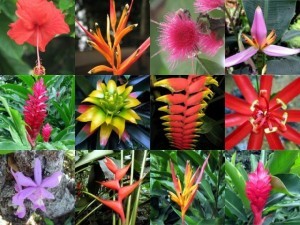
Flores Tropicais Nordeste04:49
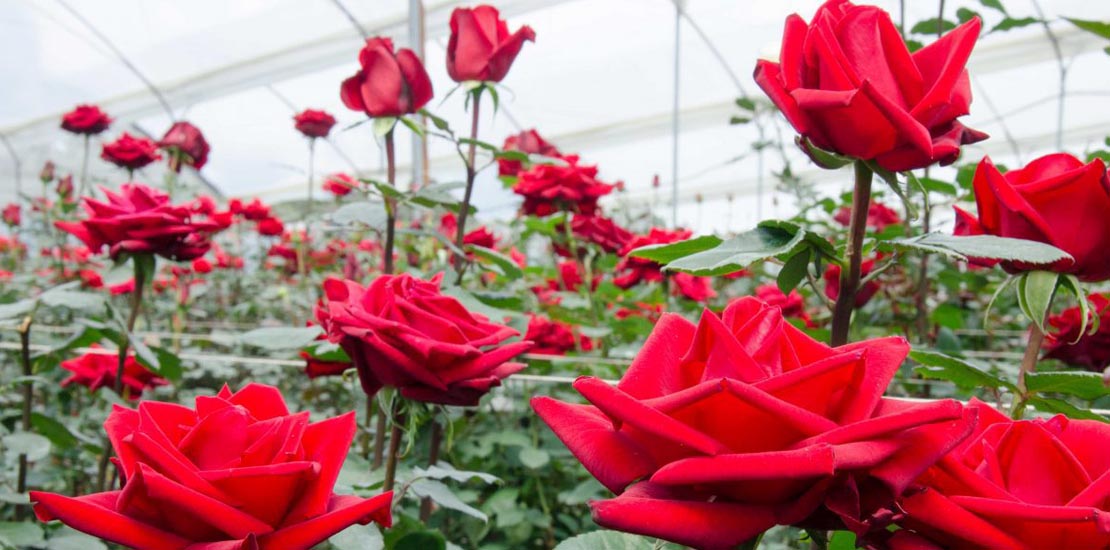
Cultivo de Rosas12:24
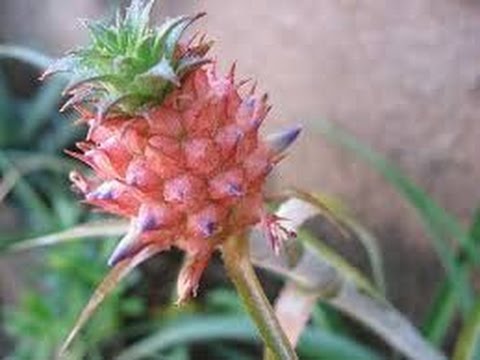
Produção de Flores03:23

Cultivar Orquídeas04:47
Growing tropical flowers in the North East
Growing tropical flowers in the North East plays a vital role in preserving some species that are disappearing due to deforestation.
As some of the world’s tropical areas continue to shrink, their commercial cultivation is a way of preserving the species.
The main varieties of tropical flowers are alpines, emperoras, tropical orchids, anthuriums, heliconias, sorrels and ornamental pineapples.
1. Alpinia Purpurata
Alpinia purpurata, also known as red ginger or ornamental ginger, is a lush, easy-to-grow tropical plant known for its striking red and pink inflorescences.
Native to the rainforests of South East Asia, this plant is popular in gardens and landscaping for its beauty and ornamental value.
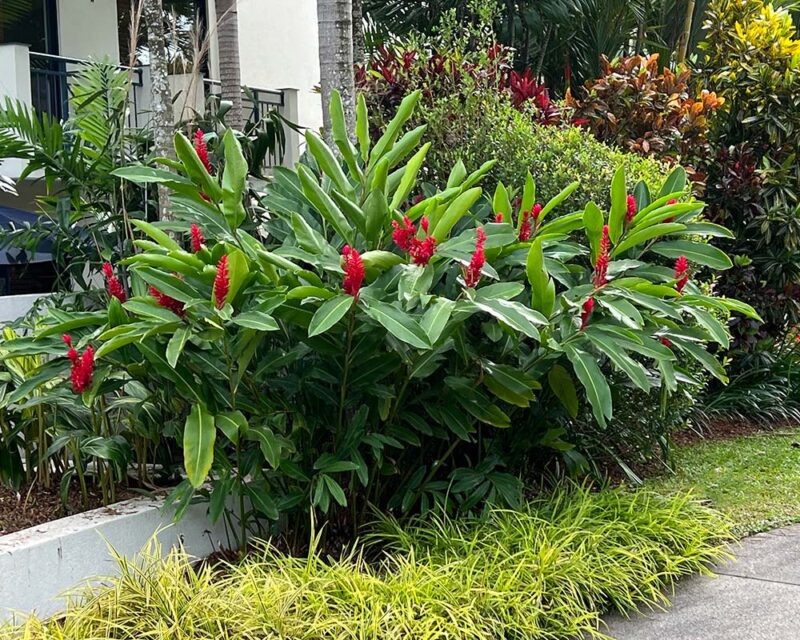
Growing
- Location: Choose a location with partial shade or filtered light as the plant can suffer from direct sunlight which can burn its leaves.
- Soil: Use a soil that is rich in organic matter, well drained and has a slightly acidic to neutral pH. Adding organic compost can help improve the quality of the soil.
- Watering: Keep the soil moist at all times, but avoid waterlogging, which can cause the roots to rot. Increase the frequency of watering during dry periods.
- Fertilising: Apply a balanced fertiliser every two months during spring and summer to encourage healthy growth.
Growth
Alpinia purpurata is a perennial that can reach a height of up to 2 metres. It grows relatively quickly, especially under ideal temperature and humidity conditions. The broad, green leaves are ornamental in themselves and give a tropical effect to the garden.
Flowering
Flowering usually occurs in summer, with inflorescences appearing at the top of the stems. The flowers are arranged in spikes that can vary in colour from red to pink and attract pollinators such as bees and hummingbirds.
To encourage flowering, it is important that the plant receives the right amount of light and nutrients. After flowering, the flowers may wither and fall off, but new shoots will appear to keep the plant alive.
In summary, Alpinia purpurata is an excellent choice for those who want to add a tropical touch to their space, offering beauty and ease of cultivation. With the right care, you’ll be able to enjoy its stunning flowers for many years to come.
Scientific name: Alpinia purpurata
Popular Name: Alpinia, Red Ginger
Family: Zingiberaceae
Category: Shrubs, Tropical Shrubs, Perennial Flowers
Climate: Equatorial, Oceanic, Subtropical, Tropical
Origin: Asia, Indonesia, Oceania
Height: 1.2 to 1.8 metres
Light: Part shade, full sun
Life cycle: Perennial 1.
2. Orchids: Beauty and Cultivation
Orchids are one of the most diverse and fascinating plant families in the world, renowned for their exotic and varied flowers.
With more than 25,000 species and countless hybrids, orchids delight gardeners and plant lovers around the world. Their beauty and complexity make them a popular choice for decoration and cultivation.
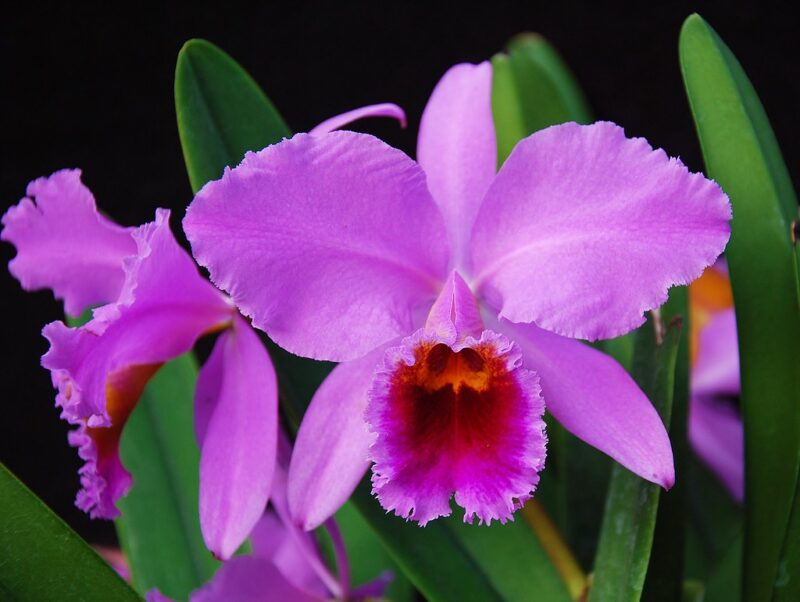
Growing
- Location: Orchids generally prefer indirect light. A window facing east or west is ideal as it provides the right amount of light without burning the leaves.
- Soil: Use a special substrate for orchids, usually made up of pine bark, charcoal and peat moss. This will ensure good drainage and aeration.
- Watering: Orchids should be watered when the substrate is almost dry. The frequency will vary according to the temperature and humidity of the environment, but generally once every week or two is sufficient.
- Humidity: These plants prefer a humid environment, so it is advisable to increase the humidity around them by using a humidifier or placing the plant on a plate of stones and water.
- Fertilising: Apply a special orchid fertiliser every 2-4 weeks during the active growing period, diluting it according to the manufacturer’s instructions.
Cultivation
Orchids can be epiphytic, terrestrial or lithophytic. Epiphytes, which are the most common, grow on other plants, using them only as a support.
They can flower once a year or more, depending on the species and growing conditions. Root growth is essential and roots must be kept healthy and well aerated.
Flowering
Orchid flowering can be a spectacle of colour and form. Flowers can last for several weeks and many growers consider flowering to be one of the greatest pleasures of orchid growing.
After flowering, some species can enter a period of dormancy during which the plant requires less water and nutrients. With the right care, orchids can continue to flower for many years.
In short, orchids are stunning plants that offer a rewarding challenge to the grower. With attention to their specific requirements for light, water and humidity, you can enjoy the beauty of these exotic flowers in your home or garden.
See Growing and caring for orchids
3. Emperor’s Wand
Etlingera elatior, popularly known as Emperor’s Wand or Malaysian Ginger, is a lush tropical plant famous for its striking pink and red flowers.
Native to the tropical forests of Southeast Asia, this plant is prized for its ornamental beauty as well as its culinary uses.

Growing
- Location: The Emperor Stick prefers a sunny position but will tolerate partial shade. An environment that receives at least 6 hours of sunlight a day is ideal for healthy growth.
- Soil: This plant grows best in soil that is rich in organic matter, well drained and has a slightly acidic to neutral pH. The addition of organic compost can improve its growth and health.
- Watering: Keep the soil moist at all times, especially during the hot months. It’s important to avoid waterlogging, which can damage the roots. Adjust watering frequency according to weather conditions.
- Fertilising: Apply a balanced fertiliser every 4-6 weeks during spring and summer to encourage vigorous growth and abundant flowering.
Growth
Etlingera elatior is a perennial that can reach a height of 2 metres. Its broad, green leaves grow on vertical stems, creating a tropical effect in the garden. The plant usually starts flowering in the summer and can continue into the autumn, depending on weather conditions.
Flowering
The flowering of the Bastão-do-Imperador is a visual spectacle. The flowers, arranged in cone-shaped inflorescences, can vary from shades of pink to red and emit a sweet scent that attracts pollinators such as bees and butterflies.
The flowers can last for several weeks and their presence in the garden is a great attraction. After flowering the plant can produce seeds which can be collected to propagate new seedlings.
Culinary uses
In addition to its ornamental beauty, Etlingera elatior plays a role in cooking, especially in Asian cuisine. The flowers and shoots are edible and can be used in salads, cooked dishes and as a garnish, adding a unique and exotic flavour to dishes.
In short, Etlingera elatior is an excellent choice for those who want to add a lively, tropical touch to their surroundings. With the right care, you’ll be able to enjoy its stunning flowers and lush growth for years to come.
Scientific name: Etlingera elatior
Common names: Emperor Stick, Redemption Flower, Wax Flower, Torch Ginger
Family: Zingiberaceae
Category: Shrubs, Tropical shrubs, Perennial flowers
Climate: Equatorial, Subtropical, Tropical
Origin: Indonesia
Height: 3.6 to 4.7 metres
Light: Part shade
Life cycle: Perennial
4. Anthuriums
Anthuriums belong to the Araceae family and their scientific name is Anthurium Andraeanum. Anthuriums are native to Central and South America.
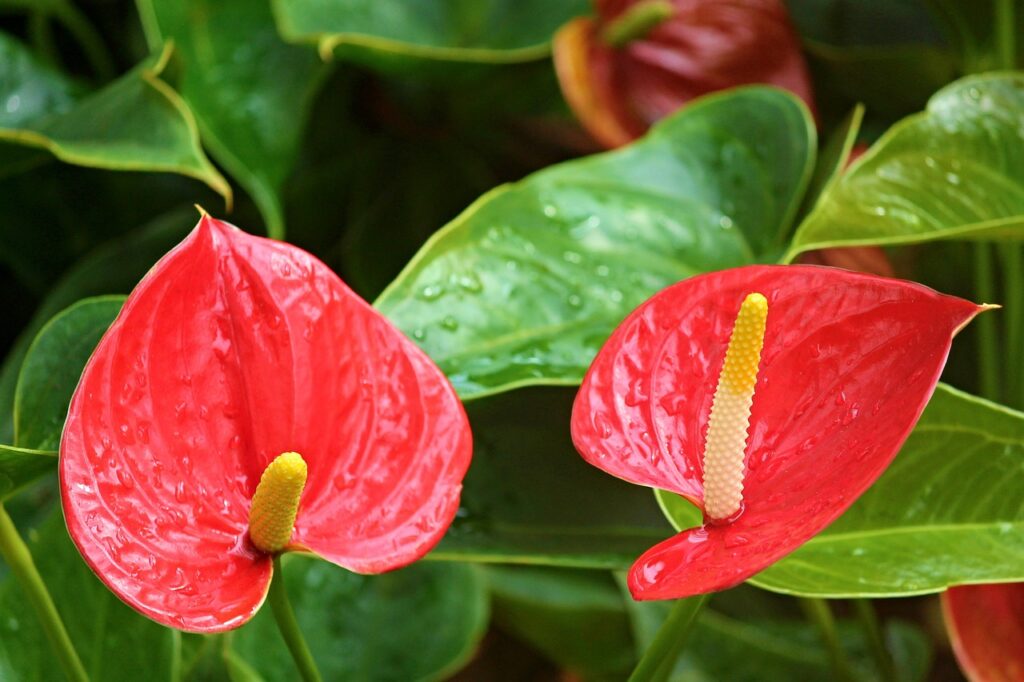
The anthurium flower is small and the colourful and exotic part that we usually think of as the flower is actually an inflorescence, i.e. the set of spadix (spike from which the tiny flowers sprout) and anthurium spathe (coloured bract or modified leaf).
The real flowers of the anthurium are the little yellow dots that sprout from the spike.
But it’s not just the beauty of the inflorescence that makes anthuriums so striking. Its heart-shaped (codiform) leaves, which vary in size depending on the variety, are extremely exotic.
Availability
Anthuriums are available all year round.
Anthurium varieties
Anthurium Alabama, Anthurium Amis, Anthurium Bird Luxury, Anthurium Black Love, Anthurium Black Queen, Anthurium Dakota, Anthurium Green King, Anthurium Natalie, Anthurium Opirus, Anthurium Otazu, Anthurium Pink Expression, Anthurium Red Queen, Anthurium Red Victory, Anthurium Red Winner, Anthurium Sierra, Anthurium Snow Ring, Anthurium Sumi, Anthurium Tangerine, Anthurium Vitara, Anthurium White Champion and Anthurium White King.
Basic care
Like any tropical plant, it needs temperatures above 15º C and half light (it can’t be in direct sunlight).
Make sure that the soil in the pot is always moist and aerated, watering 2-3 times a week, one of which can be on the plant. Transplanting will allow the anthurium to grow to a height of 90 cm, depending on its size.
5. Heliconias – Tropical charm
Tropical and exotic plants are one of the greatest riches of our flora. Lush and colourful, they are appreciated on the international market for their durability and their ability to create surprising compositions.

The Heliconia market
Heliconias have become an attractive market and it is important to know the technical aspects of growing them.
Origin and Classification
Originally from northwestern South America, Heliconia belongs to the Heliconiaceae family. The genus was named by Linnaeus in 1771 after Mount Helicon in Greece.
Diversity of species
The genus Heliconia is poorly studied, with an uncertain number of species, ranging from 150 to 250. They are mainly found in tropical America, from southern Mexico to northern Santa Catarina in Brazil.
Growing environment
Heliconias grow at altitudes from 0 to 2,000 metres, mainly on the edges of forests and in shady or sunny places, preferring sandy-clay soils.
Nomenclature and diversity in Brazil
About 40 species occur naturally in Brazil and are known by names such as bananeira-de-jardim and bico-de-guará.
Use and market acceptance
Used as garden plants or cut flowers, Heliconias have become increasingly popular on the market due to the beauty and resistance of their bracts.
Species for cut flowers
For cut flowers, species with small, light inflorescences are best, although hanging varieties are also of market value.
Characteristics of Heliconias
Heliconias are herbaceous plants that grow from 50 cm to 10 metres tall, with inflorescences that can be erect or hanging, attracting pollinators such as hummingbirds.
Reproduction and survival
Heliconias reproduce both by seeds and underground organs, ensuring the survival of the species, with flowering periods varying according to the species and climatic conditions.
Growth in the international market
The marketing of heliconias on the international market is growing, with the main producers being Jamaica and Costa Rica. In Brazil, cultivation is expanding in several states.
Heliconia propagation
Heliconias can be propagated by seed or by dividing rhizomes, which are specialised stems. Seeds germinate in about 120 days.
Growing Heliconias
Spacing and planting conditions depend on the species. The ideal time to plant is during the coldest part of the year, with temperatures between 21°C at night and 26°C during the day.
Ideal conditions for planting
It is important to maintain humidity, adequate fertilisation and controlled irrigation to avoid waterlogging of the soil.
Cultivation, pests and diseases
Clumps should be divided every two years and nematode control is essential. The main diseases are fungal and require care in cultivation.
6. Magnificent Ginger, Zingiber Spectabile or Sorbet

Magnificent Ginger is an exotic ornamental plant with an ice-cream-like shape. Ideal for gardens, it should not be eaten. With its fantastic appearance, this plant adapts well to a variety of environments and can be grown in borders, against walls or in planters.
Originally from Malaysia, this tropical plant from the Zingiberaceae family grows to a height of 1.2 to 1.8 metres and prefers partial shade.
Its erect stems and long green leaves give it a velvety appearance. The inflorescence has yellow bracts that turn pinkish red over time, resembling a pineapple.
Flowers and landscaping
The yellowish or white flowers are of great ornamental value, opening gradually between the bracts which form a distinctive texture. Magnificent Ginger is perfect for landscaping and can be grown in shady areas, with rapid growth and fragrant flowers throughout the summer.
Cultivation
Prefers fertile, moist soil and twice-weekly watering. Seedlings should be made from shoots. It is sensitive to cold and goes dormant in winter and needs protection.
It should be fed with NPK 04-14-08 to stimulate growth. Germination takes between 15 and 25 days and the plant can be grown all year round.
7. Ornamental pineapple – Ananas bracteatus
The ornamental pineapple, also known as the red pineapple, is a small plant (about 5 cm in diameter) of the Bromeliaceae family, native to South America, particularly Brazil.

Main characteristics
This hardy bromeliad is perennial, herbaceous, stemless and has a slight degree of polymorphism. It has a rosette of lanceolate, thick and broad leaves, and its leaves and fruits are purely ornamental as they are not grown for consumption.
Adaptation and use
Adaptable to humid tropical and subtropical climates, the ornamental pineapple is sensitive to low temperatures and is often used for decoration because of its unique characteristics. Its thorns can also be used to create borders.
Leaves
The leaves are oblong, greenish and spiny, between 0.7 and 1.0 m long and 3.0 to 4.0 cm wide.
Fruit
The red fruits are about 5cm in diameter, fibrous and inedible, used for decoration only.
Flowering
The plant will flower at any time of the year and should be grown in full sun or partial shade in a fertile, well-drained soil. Water regularly and avoid cold and frost.
Reproduction
The Ornamental Pineapple is easily propagated by dividing the clump and by cuttings formed on the crowns of the fruit.
Cultivation
It can be grown in pots, but it is essential to keep the temperature above 15 degrees and to wear thick gloves when handling it because of the thorns.
Scientific name: Ananas bracteatus
Common names: Pineapple Ornamental, Pineapple Red, Pineapple Ornamental, Pineapple Red
Family: Bromeliaceae
Category: Shrubs, Tropical shrubs, Bromeliads
Climate: Equatorial, Subtropical, Tropical
Origin: South America, Brazil
Height: 0.6 to 0.9 metres
Light: Full sun
Life cycle: Perennial.
Publicações Relacionadas
Influences and main dishes of northeastern cuisine
Maranhão's handicrafts have more than 400 years of tradition
Casa Grande & Senzala: The Work of Gilberto Freyre
Spinner Dolphins in Fernando de Noronha: A Guide
Fine Arts in the Brazilian Northeast
Tracunhaém and Its Rich Clay Handicraft Tradition
Northeastern architecture marked by typical features of colonial structures
Orchids of the Chapada Diamantina in Bahia
José Américo de Almeida left Paraíba to revolutionize northeastern literature
Candombá is a typical flower of the Chapada Diamantina
The influence of Arab architecture on the buildings of Pernambuco
Rapadura continues in the daily life of the northeasterner to this day
History of the introduction of Portuguese tiles in Brazil
History and evolution of the Trio Elétrico
Why go to the Brazilian Northeast?
Orchids: Tips and Techniques for Efficient Cultivation and Care
Music and Rhythms of the Brazilian Northeast
History and origin of Northeastern literature and biography of the main authors
This post is also on:
![]() Português
Português ![]() English
English ![]() Deutsch
Deutsch ![]() Español
Español ![]() Français
Français



















